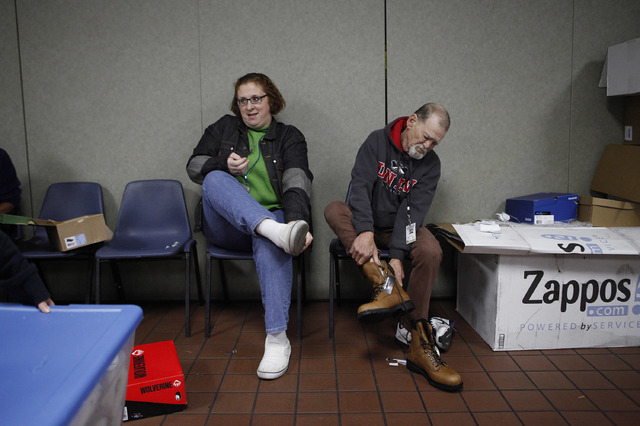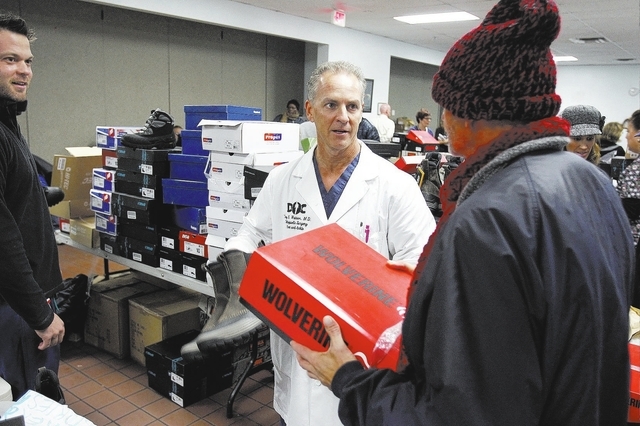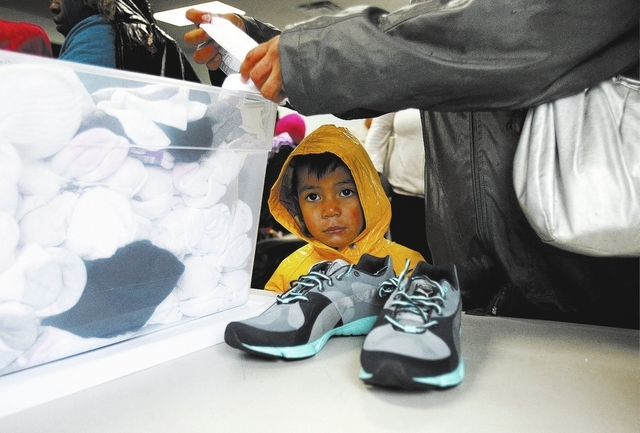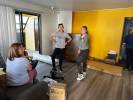Shoe giveaway helps brighten outlook for low-paid, homeless
It looks a bit like the scene of a Black Friday sale at a discount shoe store, with filled shoe boxes stacked on tables, empty shoe boxes strewn about and determined shoppers hunting intently through a quickly dwindling stock.
But, unlike your typical shoe-buying event, the footwear made available just more than a week ago at The Salvation Army Southern Nevada — including work boots, sneakers in a rainbow of colors, waterproof ankle-length boots and dressy loafers — was being given out free to valley homeless and low-income people.
And on a chilly, windy day when it began raining and never really stopped, a new pair of dry shoes was a particularly nice gift to walk away with.
The shoe distribution was organized by Dr. Troy Watson, an orthopedic surgeon and director of Desert Orthopaedic Center’s Foot and Ankle Institute. This year’s edition was the seventh annual event Watson and his staff organized to provide local homeless and low-income residents with not just a new pair of shoes but, if you think about it, the key to their mobility.
Watson, who throughout his medical career has provided health care to homeless and low-income people, said the event here has grown each year.
“Why? There’s a need,” Watson said. “Unquestionably, everybody comes in here and they’re so excited to get a new pair of shoes. Most of these people can’t afford a new pair of shoes. Certainly, insurance, if you had it, isn’t going to buy you a new pair of shoes. So this is really, for a lot of people, the one pair of shoes they get for the year.”
Most of the 750-plus pairs of shoes scheduled for distribution this year were donated by Zappos, the Las Vegas-based online retailer. But along with new shoes and a few pairs of socks, clients received a quick foot health screening and the chance to spend a few minutes talking with Watson about their own foot problems.
During the more-than-three-hour event, Watson walked several times to the area where clients were being fitted to discuss a proper shoe for them, or suggest a more comfortable size of shoe, or examine a potential health issue a fitter may have discovered.
Homeless and low-income people often delay seeking, or simply can’t afford to obtain, regular medical care and may not manage adequately such chronic conditions as diabetes. Therefore, it’s not surprising that foot problems they may suffer tend to be ignored.
“Unfortunately, a lot of these people don’t have insurance,” Watson said. “Some will have Medicaid, which is awfully helpful because it allows me to offer them a little bit more. If they have no insurance, it’s a little bit tougher for them to get health care.
“So we’ll look at what (clients) want us to look at. If it’s something acute, I usually will send them over to UMC (University Medical Center) and say, ‘You need to be seen by emergency (staff) somewhere.’ ”
Among homeless and low-income people, Watson said he worries most about open sores on feet.
“So ulcers — diabetic ulcers — would be a big red flag for me, especially if they look at all infected,” he said. “We want to get those people acute treatment if we can.
“Other things we see are congenital deformities, and we see deformities that are post-traumatic in nature, and those people need special shoes. I saw a guy earlier today who has previous fractures. He had some issues around the ankle, and those people need special shoes.
“Then there’s all the routine stuff — ingrown toenails, toenail fungus, which we call onychomycosis, corns and calluses, all of the things I see in my office every day.”
Watson added that some of the homeless and low-income people he sees do share one thing with patients who come to his office: Both can be reluctant to seek treatment for foot and ankle problems.
“Even patients who are well-insured, they’ll just procrastinate because they’re afraid of what they might need — i.e. surgery,” Watson said. “So a lot of people put off their problems, hoping that things go away on their own, and often they don’t.”
For the sixth year, orthotist Elden Henry-Pottinger volunteered his time to Watson’s effort, helping to fit clients for their new shoes. He said many of the homeless and low-income people he sees wear ill-fitting — and probably secondhand — shoes.
But, he added, “I would say, in our practice, 95 percent of people come in in the wrong-sized shoes. That, itself, can cause a lot of problems over time.”
Also, Henry-Pottinger said, “dry socks are so important, because your shoes are a breeding ground for bacteria. So you’re talking about athlete’s foot and, on a diabetic, (the potential for) ulcers and gangrene.”
If, during a fitting, Henry-Pottinger sees a sign that something is amiss, he’ll call Watson over for a look. Yet, he said, the client more often than not will decline the help.
“I mean, I’ll look at their feet, and if they’ve got, say, bunions or bleeding — that’s a telltale sign something is wrong — I’ll say, ‘You should go see the doctor. He’s right here, it’ll take just a few minutes.’ And a lot of times, they’ll say, ‘No, I’m OK.’
“They’re just like the rest of us. Sometimes ignorance is bliss.”
Phillip Hollon, social services director for The Salvation Army Southern Nevada, said shoes are particularly important for the homeless, and not only for the protection from the elements they offer.
“Their mode of transportation is their shoes. They don’t have an automobile,” he said. “So the wear and tear they put on their shoes is enormous, and it’s important to have good-fitting shoes to be able to get around and access the services that can help them to be successful.”
“A new pair of shoes is a new mode of transportation for them,” Hollon said. “It’s a new car.”
Henry-Pottinger saw a few familiar faces during this year’s screening, including some people who were wearing the pair of shoes they received at last year’s event. Clients, he said, invariably have “a sense of gratitude” when they receive their new shoes.
“It means a lot,” said Tijuana Nicks, who is unemployed. She and her son Demond Henry, 10, each left with a pair of new sneakers.
“Right now, I don’t have much money. It’s just enough to keep the lights and gas on,” she said. “But it means a lot to me. I’m very excited.”
Mike Hill, who walked in wearing used, and now wet, sneakers, carried his new shoes out with him.
“I can’t wait to change into them,” he said. “Definitely, I can’t wait to change into them.”
After picking up his new shoes, Jimmy Laird, clutching a few pairs of new socks, too, made it a point to come back and thank Henry-Pottinger again for his help.
“I’m homeless and out of work,” Laird said. “I’m almost 62 years old. I don’t get no check and I sleep outside.”
But he is looking for a job, and says having a pair of new shoes may help him to land one.
“It made my day. It made my birthday,” Laird said, smiling and adding that Thanksgiving Day would be his birthday.
Contact reporter John Przybys at jprzybys@reviewjournal.com or 702-383-0280.































